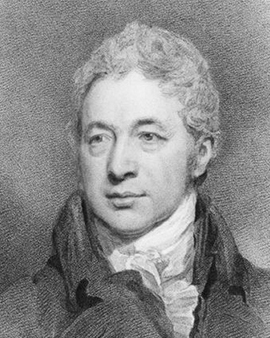Robert Smirke (1753 - 1845) was born the son of an eccentric itinerant painter. When he moved to London in the wake of his father's work at the age of 12, he apprenticed with the carriage painter Bromely. At the age of 20, he was finally accepted for study at the Royal Academy Schools. Later, Smirke was initially a member of the Incorporated Society of Artists, where he exhibited his first works. He did not become a full member of the Royal Academy until 1791, when he exhibited his work "The Widow" there. For his thesis at the Academy, he submitted the work "Don Quixote and Sancho" in 1793.
Smirke was highly respected at the Royal Academy and was proposed as Academy Keeper in 1804 to succeed Joseph Wilton. However, King George III opposed Smirke's appointment. This was because he disliked Smirke's openly expressed political views. The king feared that Smirke might pass on his revolutionary views to the young students. So Smirke was passed over in the election and Johann Heinrich Füssli got the job. Smirke exhibited for the last time at the Royal Academy in 1813. The painting was titled "Childhood." He exhibited a few more works outside the Academy in the following years until about 1834.
Smirke mainly painted pictures in small size, often using monochrome colors. Therefore, his works were well suited for engraving and were used by some engravers such as Joseph Goodyear and William Finden. Many of his paintings had a sentimental or a humorous to satirical character. In addition to his various paintings, Robert Smirke also tried his hand as an illustrator. He produced illustrations for the Bible, but also for some international literary classics, such as "The Arabian Nights" or "Don Quixote", which was translated by his daughter Mary Smirke. Robert Smirke had four sons and at least one daughter. Two of his sons, Robert and Sidney became famous architects and were also members of the Royal Academy. His son Richard became a notable antiquarian artist and his son Edward became a lawyer.
×





.jpg)
.jpg)
.jpg)
.jpg)
.jpg)
.jpg)
.jpg)
.jpg)
.jpg)
.jpg)
.jpg)
.jpg)
.jpg)
.jpg)
.jpg)
.jpg)
.jpg)
.jpg)
.jpg)
.jpg)
.jpg)
.jpg)
.jpg)
.jpg)
 1797 - (MeisterDrucke-91072).jpg)
 1797 - (MeisterDrucke-91072).jpg)
.jpg)
.jpg)
.jpg)
.jpg)
.jpg)
.jpg)
.jpg)
.jpg)
.jpg)
.jpg)
.jpg)
.jpg)
.jpg)
.jpg)
.jpg)
.jpg)
 - (MeisterDrucke-124947).jpg)
 - (MeisterDrucke-124947).jpg)
.jpg)
.jpg)
.jpg)
.jpg)
.jpg)
.jpg)
.jpg)
.jpg)
_to_-_(MeisterDrucke-1359959).jpg)
_to_-_(MeisterDrucke-1359959).jpg)
.jpg)
.jpg)
.jpg)
.jpg)
.jpg)
.jpg)
![[One from] Illustrations to Shakespeare by Robert Smirke [One from] Illustrations to Shakespeare by Robert Smirke](/kunstwerke/300px/Robert_Smirke_-_One_from_Illustrations_to_Shakespeare_-_(MeisterDrucke-1441658).jpg)
![[One from] Illustrations to Shakespeare by Robert Smirke](/kunstwerke/400w/Robert_Smirke_-_One_from_Illustrations_to_Shakespeare_-_(MeisterDrucke-1441658).jpg)
.jpg)
.jpg)
.jpg)
.jpg)
.jpg)
.jpg)
.jpg)
.jpg)
.jpg)
.jpg)
.jpg)
.jpg)
.jpg)
.jpg)
.jpg)
.jpg)
.jpg)
.jpg)
.jpg)
.jpg)
.jpg)
.jpg)
_to_Cap_-_(MeisterDrucke-1510272).jpg)
_to_Cap_-_(MeisterDrucke-1510272).jpg)
.jpg)
.jpg)
.jpg)
.jpg)
.jpg)
.jpg)
.jpg)
.jpg)
.jpg)
.jpg)
.jpg)
.jpg)
.jpg)
.jpg)
.jpg)
.jpg)
.jpg)
.jpg)
.jpg)
.jpg)
.jpg)
.jpg)
.jpg)
.jpg)
 Receiving Sir Harfo - (MeisterDrucke-553291).jpg)
 Receiving Sir Harfo - (MeisterDrucke-553291).jpg)
.jpg)
.jpg)
.jpg)
.jpg)
.jpg)
.jpg)
.jpg)
.jpg)
.jpg)
.jpg)
.jpg)
.jpg)
.jpg)
.jpg)
.jpg)
.jpg)
.jpg)
.jpg)
.jpg)
.jpg)
_-_Drenkeling_komt_bij_kennis_in_zijn_bedThe_Young_Man_restored_to_Life_Le_meme_Je_-_(MeisterDrucke-1357242).jpg)
_-_Drenkeling_komt_bij_kennis_in_zijn_bedThe_Young_Man_restored_to_Life_Le_meme_Je_-_(MeisterDrucke-1357242).jpg)
.jpg)
.jpg)
.jpg)
.jpg)
.jpg)
.jpg)
.jpg)
.jpg)
.jpg)
.jpg)
.jpg)
.jpg)
 - (MeisterDrucke-635550).jpg)
 - (MeisterDrucke-635550).jpg)
.jpg)
.jpg)
.jpg)
.jpg)
.jpg)
.jpg)
.jpg)
.jpg)
.jpg)
.jpg)
.jpg)
.jpg)
.jpg)
.jpg)
.jpg)
.jpg)
.jpg)
.jpg)
.jpg)
.jpg)
.jpg)
.jpg)
.jpg)
.jpg)
.jpg)
.jpg)
.jpg)
.jpg)
.jpg)
.jpg)
.jpg)
.jpg)
.jpg)
.jpg)
.jpg)
.jpg)
.jpg)
.jpg)
.jpg)
.jpg)
.jpg)
.jpg)
.jpg)
.jpg)
.jpg)
.jpg)
.jpg)
.jpg)
.jpg)
.jpg)
_-_Lichaam_van_een_jongeman_wordt_uit_een_rivier_getildThe_Body_of_a_Young_Man_take_-_(MeisterDrucke-1356803).jpg)
_-_Lichaam_van_een_jongeman_wordt_uit_een_rivier_getildThe_Body_of_a_Young_Man_take_-_(MeisterDrucke-1356803).jpg)






